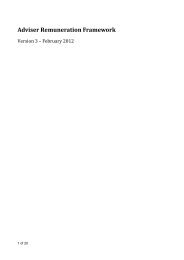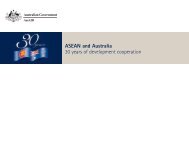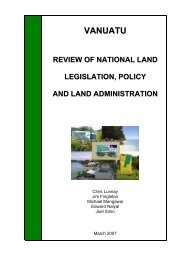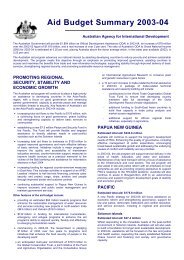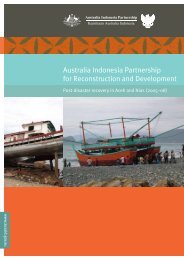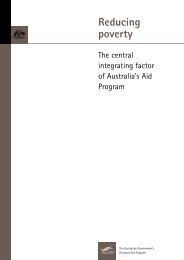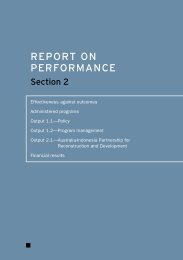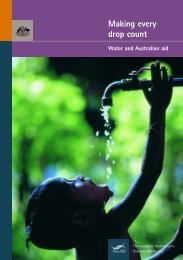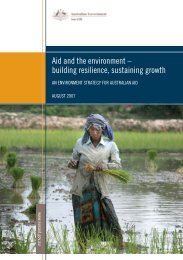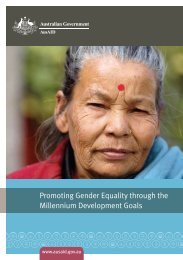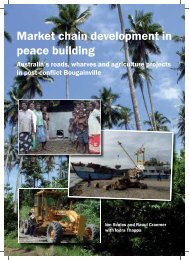• Provided core funding <strong>to</strong> the <strong>PNG</strong> Institute for Medical Research in recognition ofits contribution <strong>to</strong> malaria research, as well as broader disease control studies,including in the area of HIV and pneumonia and operational research supportinghealth delivery.• Enhanced operational efficiency of hospital services in 5 base hospitals, through anumber of planning, administrative, financial and human resource managementimprovements.• Provided technical assistance for development of annual work programs,budgeting and financial management in 6 provincial hospitals and 20 provincialhealth departments.• Improved and broadened the skills and knowledge base of <strong>PNG</strong> medical students,specialists, and residents by providing <strong>Australian</strong> medical specialists for shortperiods each year for cost-effective in-country training and consultancy services<strong>to</strong> hospitals. This assistance has also yielded less tangible benefits such asgoodwill between the medical professions of both countries.• Established <strong>PNG</strong>’s first degree-level health administration course.• Introduced a new student-centred curriculum at the University of Papua NewGuinea medical faculty.• Provided extensive training for medical officers, including 99 specialist medicalofficers (there were no such <strong>PNG</strong> specialists in the early 1970s).• Provided extensive training for nurses, biomedical technicians, rural health staff,hospital staff, specialist STD clinic workers, district health workers, healthadministra<strong>to</strong>rs, and hospital Board members and chief executives.At this stage, higher order outcomes of individual health projects are difficult<strong>to</strong> measure because the vast bulk of Australia’s programmed assistance in thehealth sec<strong>to</strong>r has only been provided in the last five years, and improvementsin key health indica<strong>to</strong>rs tend <strong>to</strong> take place over a much longer time frame.Also, it is difficult <strong>to</strong> isolate the effects of individual projects on healthindica<strong>to</strong>rs, since there are many other fac<strong>to</strong>rs that can affect health status, suchas access <strong>to</strong> clean water, health education, access <strong>to</strong> transport networks, etc.According <strong>to</strong> the Health Sec<strong>to</strong>r Moni<strong>to</strong>ring and Review Group, the healthsystem is only responsible for about 20% of the impact on mortality etc, withmost impact attributable <strong>to</strong> external fac<strong>to</strong>rs. Further, there is evidence thatpopulation figures were miscalculated during the 1990 census, which will haveaffected the reliability of a number of commonly used indica<strong>to</strong>rs of healthtrends. With these caveats, examination of improvements in social indica<strong>to</strong>rs(see Section 1) indicates that, while Papua New Guinea’s health status remainsextremely poor when compared with other similar countries, there have in factbeen a number of marked improvements since independence. Life expectancy,while still low, has improved significantly. Infant and child mortality rates have44 The Contribution of <strong>Australian</strong> <strong>Aid</strong> <strong>to</strong> Papua New Guinea’s Development 1975–2000
also improved 24 , and there is evidence of a reduction in some preventablediseases such as malaria and pneumonia. Likewise, there is some evidence thatimprovements have followed aid interventions. For example, deaths fromimmunisable diseases have reduced in periods following major donor-fundedimmunisation campaigns in Papua New Guinea.5.4 InfrastructureIn <strong>to</strong>tal, Australia has provided A$0.5 billion <strong>to</strong> support infrastructuredevelopment in Papua New Guinea, more than 80% of which has been in thetransport sec<strong>to</strong>r, particularly roads and civil aviation. Analysis of Papua NewGuinea’s performance in the infrastructure sec<strong>to</strong>r, and the contribution of<strong>Australian</strong> aid, indicates that the main impacts have been related <strong>to</strong> preventingrapid decline of essential infrastructure. Government funding for roadmaintenance, for example, has consistently been inadequate since the late 1980s,if not earlier. The bulk of <strong>Australian</strong> aid for infrastructure since 1993 (some$320 million) has been spent maintaining and rehabilitating roads and bridges.This has been sufficient <strong>to</strong> cover about 25% of the national road network. Otherdonors are also providing substantial assistance <strong>to</strong> maintain land transportinfrastructure. Papua New Guinea’s economic performance would have beeneven worse without this support, given the key role of accessible roads inenabling commercial activity, and the country would have faced much higherrisk of social tension and instability. Yet even this volume of aid is insufficientand, in the current fiscal environment, unsustainable. Overall, roads arecontinuing <strong>to</strong> deteriorate rapidly, and this is affecting other basic services thatdepend on land transport for access (such as health and education facilities). It isalso imposing further constraints on private sec<strong>to</strong>r and rural development, andefforts <strong>to</strong> achieve social cohesion. Even under an optimistic scenario, whereadequate internal funding is available for maintenance and upgrading ofexisting infrastructure, Papua New Guinea will face significant challenges wellin<strong>to</strong> the future in being able <strong>to</strong> maintain its existing road network, let alonefinance new major roads that may have high economic returns.Likewise, in civil aviation, <strong>Australian</strong> assistance has been instrumental inensuring the national airline carrier (Air Niugini) could continue operations overseveral years since independence. Unfortunately, these achievements have yet <strong>to</strong>prove sustainable, and the situation remains tenuous. As recently as mid-January2003, Australia's Civil Aviation Safety Authority threatened not <strong>to</strong> renew PapuaNew Guinea's Air Opera<strong>to</strong>r's Certificate 25 , over concerns about safety standards.24 Deeper analysis of these statistics is needed before firm conclusions can be drawn, as discernible trends differdepending on the data source used.25 Extended for three months from 31 January 2003.The Contribution of <strong>Australian</strong> <strong>Aid</strong> <strong>to</strong> Papua New Guinea’s Development 1975–2000 45
- Page 5 and 6:
BOXESBox 3.1 The Dutch Disease in P
- Page 7 and 8: FOREWORDAs part of a broader focus
- Page 11 and 12: programs to improve living standard
- Page 13 and 14: sector since independence, 65% has
- Page 15 and 16: 1 INTRODUCTIONThis report provides
- Page 17 and 18: Figure 2.1 Real GDP per capita in P
- Page 19 and 20: 1985 1990 1995 2000PNG HPC LIC LMC
- Page 21 and 22: significant strain on the budget an
- Page 23 and 24: • Improved central coordination a
- Page 25 and 26: Connell (1998, pp. 311-2) highlight
- Page 27 and 28: y the successful mobilisation of cu
- Page 29 and 30: 3 INTERPRETING THE DEVELOPMENT ANDG
- Page 31 and 32: The estimated increase in private c
- Page 33 and 34: 3.4 Reconciling the Growth and Deve
- Page 35 and 36: 3.5 Implications for AidTo summaris
- Page 37 and 38: Although the precise extent of the
- Page 39 and 40: program saw a decline in the overal
- Page 41 and 42: criticism that the withdrawal of Au
- Page 43 and 44: Ministerial Forum found that real p
- Page 45 and 46: management for Papua New Guinea, ov
- Page 47 and 48: 5 THE IMPACT OF AUSTRALIAN AID INPA
- Page 49 and 50: • Improved retention rates at sch
- Page 51 and 52: • Achieved operational efficienci
- Page 53 and 54: policing are being introduced, alon
- Page 55 and 56: deliver community and public servic
- Page 57: BOX 5.5 HEALTH IMPACTS OF AUSTRALIA
- Page 61 and 62: 5.5 Renewable ResourcesIn total, Au
- Page 63 and 64: Land Use Management• Established
- Page 65 and 66: New Guinea needs donor financing fo
- Page 67 and 68: only assist within the context of t
- Page 69 and 70: Both within sectors and more broadl
- Page 71 and 72: However, it seems reasonable to arg
- Page 73 and 74: useful to document the findings of
- Page 75 and 76: ANNEX A EVOLUTION OF AUSTRALIAN AID
- Page 77 and 78: ANNEX B SECTOR BREAKDOWN OF AUSTRAL
- Page 79 and 80: 8 REFERENCESAhai, N., 1988, The Dev
- Page 81 and 82: Garnaut, R., and Baxter, P., 1984,
- Page 83 and 84: Growth Strategy, Final Report, prep



